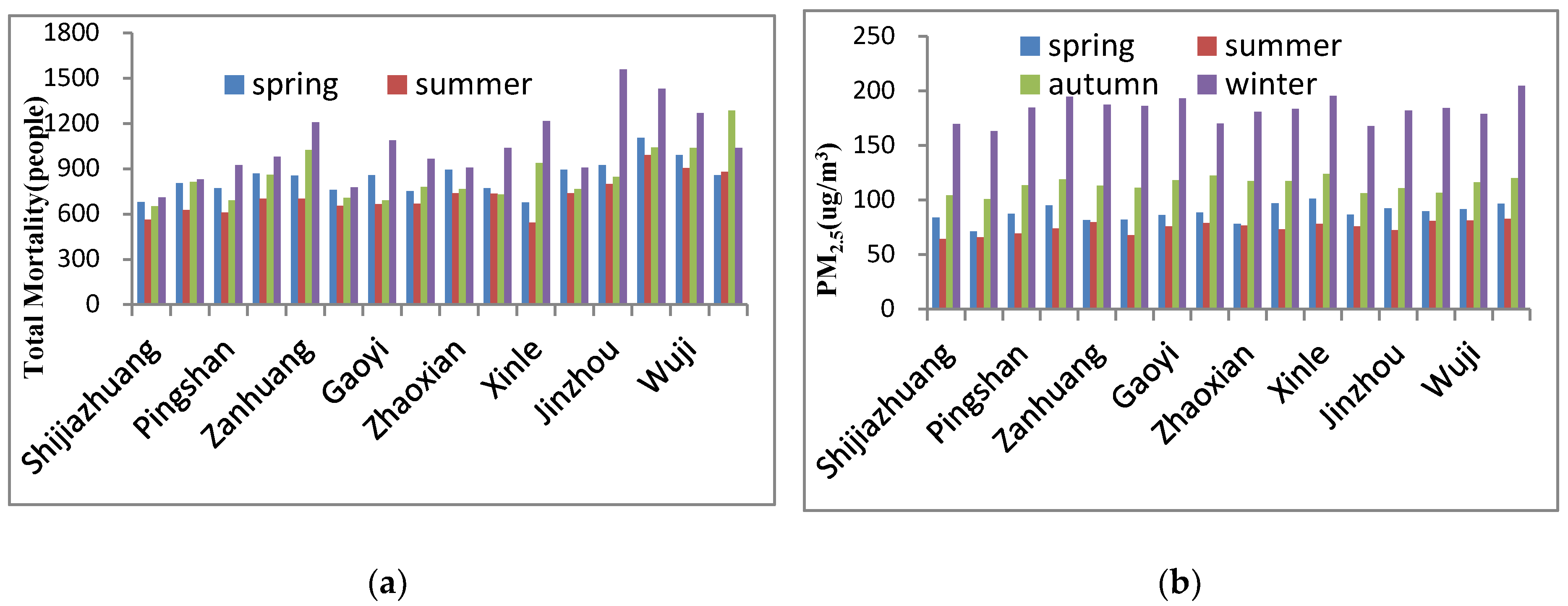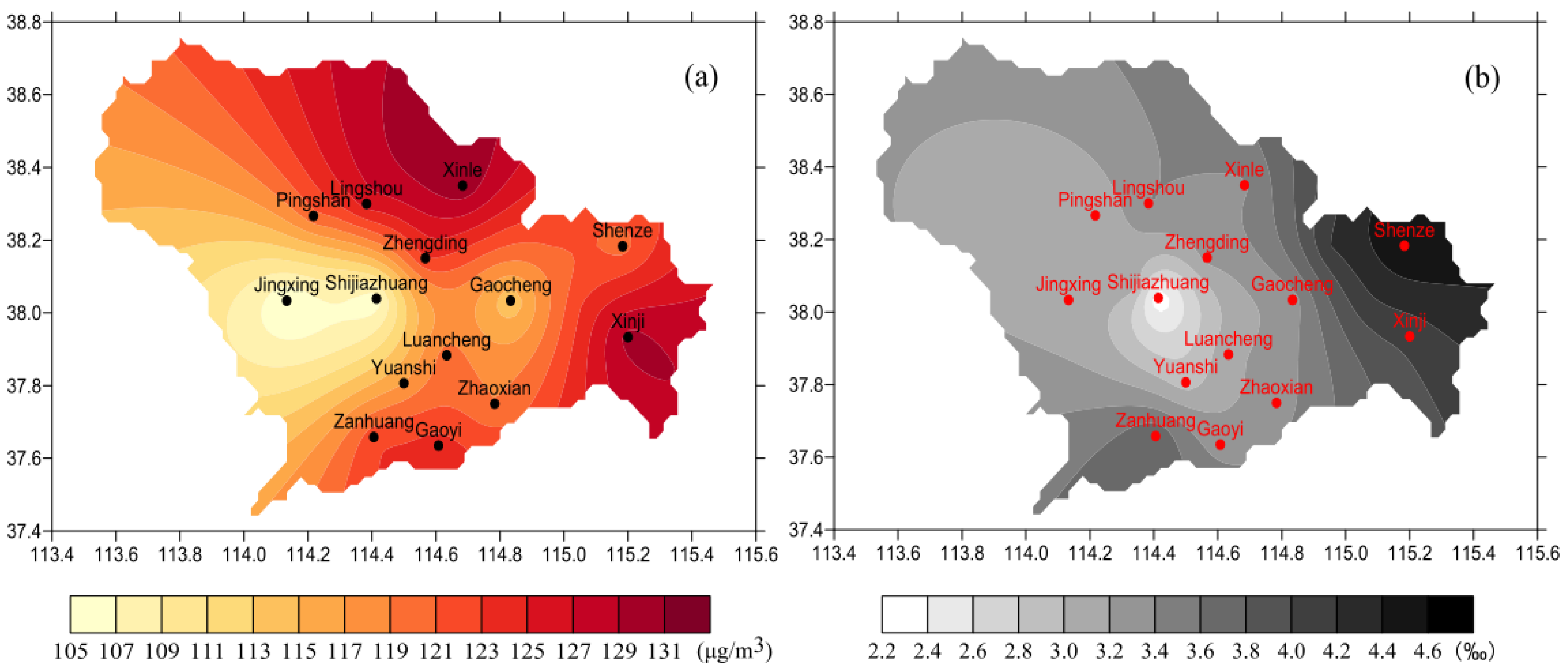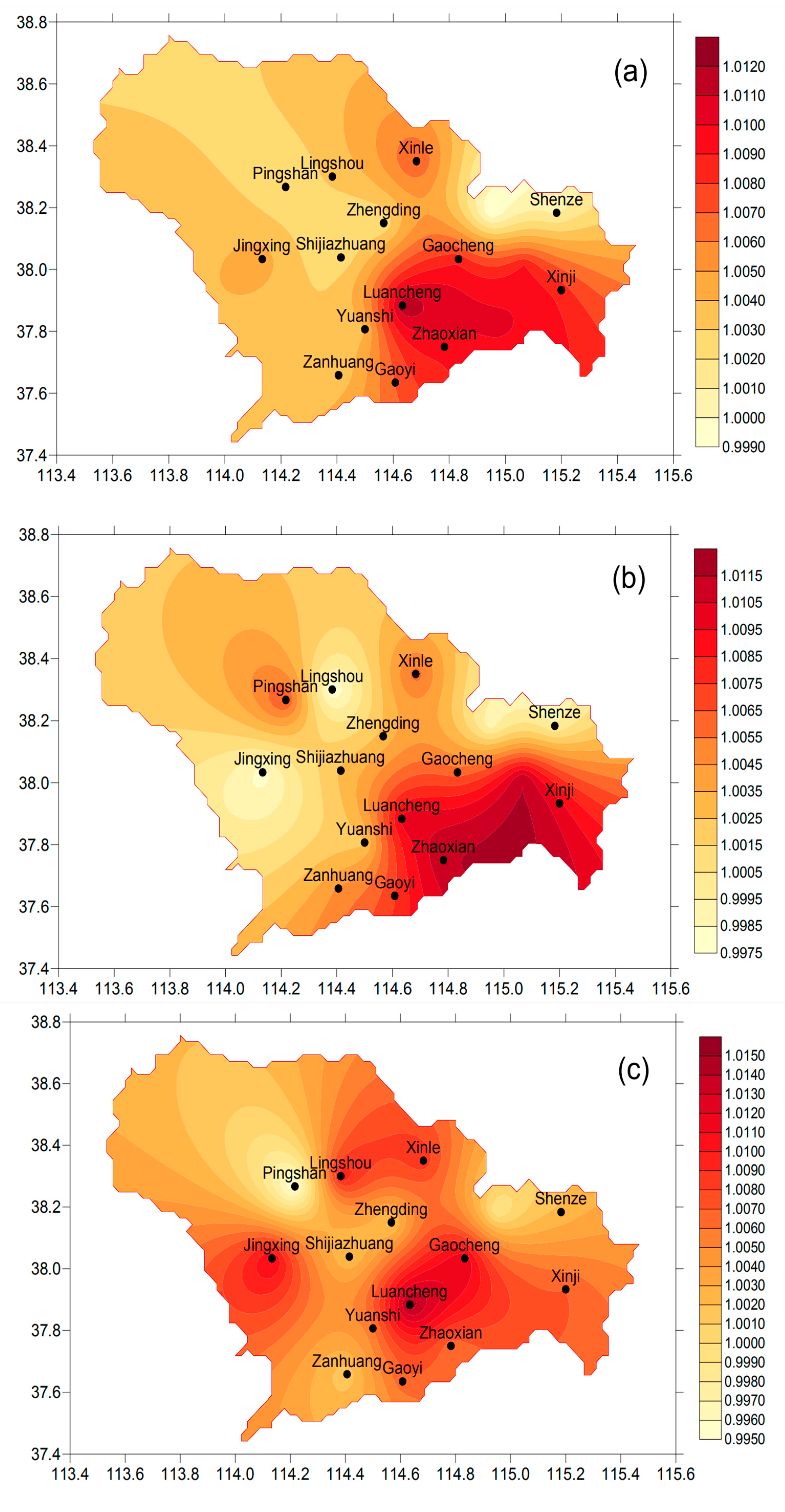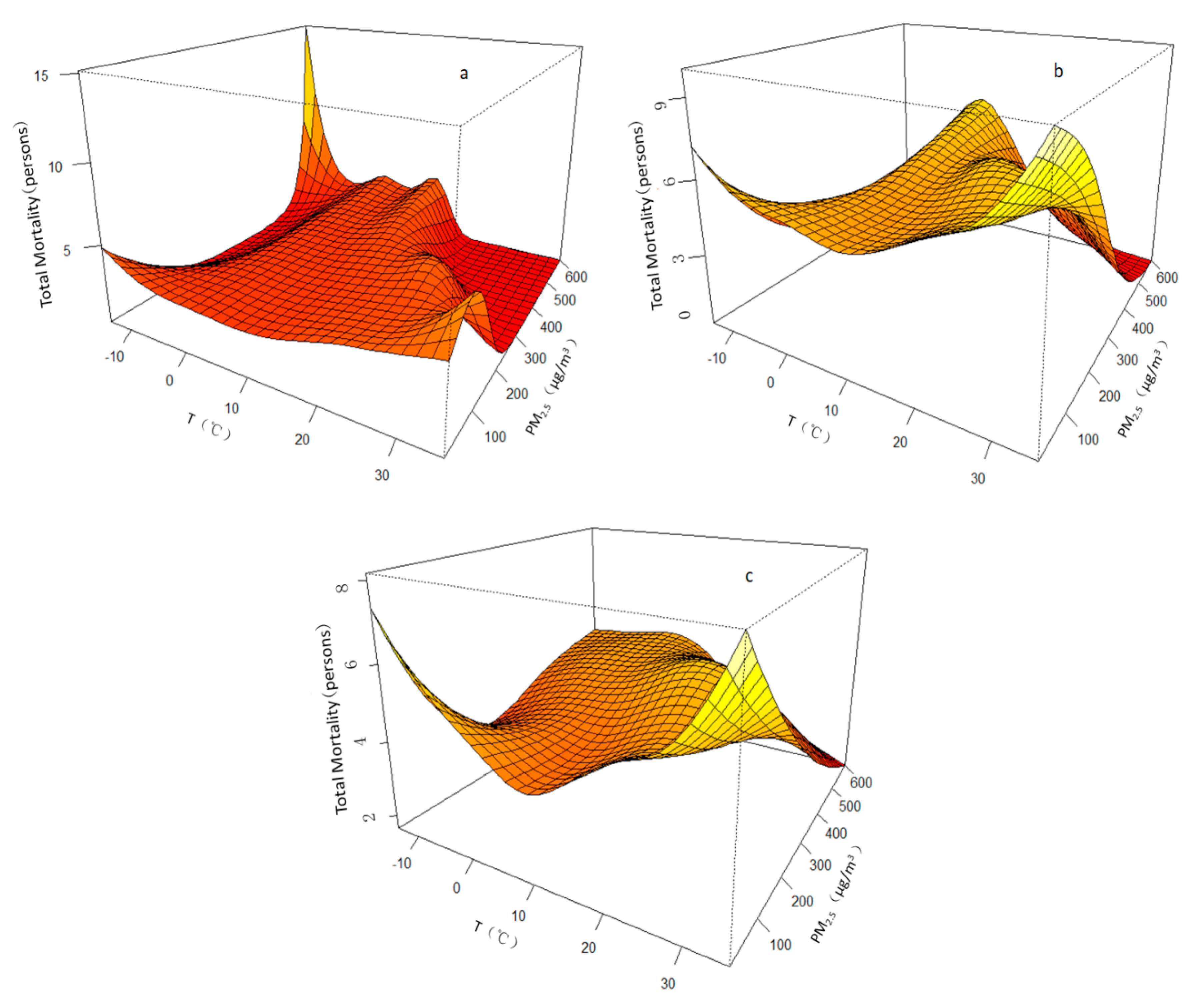Assessment of the Impact of PM2.5 Exposure on the Daily Mortality of Circulatory System in Shijiazhuang, China
Abstract
1. Introduction
2. Shijiazhuang Air Quality Data and Methods
2.1. Study Area and Air Quality Data
2.2. Methods
2.3. Quality Control
3. Results
3.1. Statistical Characteristics of the Number of Deaths from Circulatory Diseases, PM2.5 Monitoring Concentrations and Meteorological Factors in Shijiazhuang City
3.2. Seasonal Variation of the Number of Deaths in the Circulatory System and PM2.5 Concentration
3.3. Spatial Distribution of the PM2.5 Concentration and Circulatory System Mortality in Shijiazhuang from 2014 to 2016
3.4. Exposure-Response Relationship between the PM2.5 Concentration and Total Circulating Deaths in Shijiazhuang
3.5. Lagging Effect of PM2.5 Exposure on the Death Number of Circulatory System Diseases
3.6. Spatial Distribution of the Relative Risk (RR) of Exposure to PM2.5 on the Mortality of Circulatory System Diseases
3.7. PM2.5 Synergistic Effect of Exposure and Air Temperature on Circulatory Death
4. Discussion
5. Conclusions
Author Contributions
Funding
Conflicts of Interest
References
- Apte, J.S.; Marshall, J.D.; Cohen, A.J.; Brauer, M. Addressing global mortality from ambient PM2.5. Environ. Sci. Technol. 2015, 49, 8057–8066. [Google Scholar] [CrossRef]
- Wehner, B.; Birmili, W.; Ditas, F.; Wu, Z.; Hu, M.; Liu, X.; Mao, J.; Sugimoto, N.; Wiedensohler, A. Relationships between submicrometer particulate air pollution and air mass history in Beijing, China, 2004–2006. Atmos. Chem. Phys. Discuss. 2008, 8, 11321–11362. [Google Scholar] [CrossRef]
- Dominci, F.; Peng, R.D.; Bell, M.L.; Pham, L.; McDermott, A.; Zeger, S.L.; Samet, J.M. Fine particulate air pollution and hospital admission for cardiovascular and respiratory diseases. JAMA 2006, 295, 1127. [Google Scholar] [CrossRef]
- Qin, F.G.; Feng, J.Y.; Ping, L.L.; Yue, L.H.; Ji, Z.; Wei, C.X.; Gong, W.S. Effects of PM 2.5 Exposure in Different Air Quality Grades on Daily Outpatient Visits for Childhood Asthma in Shijiazhuang, China. Biomed. Environ. Sci. 2018, 31, 888–892. [Google Scholar] [CrossRef]
- Hou, Q.; An, X.; Tao, Y.; Sun, Z. Assessment of resident’s exposure level and health economic costs of PM10 in Beijing from 2008 to 2012. Sci. Total Environ. 2016, 557–565. [Google Scholar] [CrossRef]
- Evans, J.; van Donkelaar, A.; Martin, R.V.; Burnett, R.; Rainham, D.G.; Birkett, N.J.; Krewski, D. Estimates of global mortality attributable to particulate air pollution using satellite imagery. Environ. Res. 2013, 120, 33–42. [Google Scholar] [CrossRef]
- Lim, S.S.; Vos, T.; Flaxman, A.D.; Danaei, G.; Shibuya, K.; Adair-Rohani, H.; Amann, M.; Anderson, H.R.; Andrews, K.G.; Aryee, M.; et al. A comparative risk assessment of burden of disease and injury attributable to 67 risk factors and risk factor clusters in 21 regions, 1990–2010: A systematic analysis for the global burden of disease study 2010. Lancet 2012, 380, 2224–2260. [Google Scholar] [CrossRef]
- Yang, G.; Wang, Y.; Zeng, Y.; Gao, G.; Liang, X.; Zhou, M.; Wan, X.; Yu, S.; Jiang, Y.; Naghavi, M.; et al. Rapid health transition in China, 1990–2010: Findings from the global burden of disease study 2010. Lancet 2013, 381, 1987–2015. [Google Scholar] [CrossRef]
- Cohen, A.J.; Brauer, M.; Burnett, R.; Anderson, H.R.; Frostad, J.; Estep, K.; Balakrishnan, K.; Brunekreef, B.; Dandona, L.; Dandona, R.; et al. Estimates and 25-year trends of the global burden of disease attributable to ambient air pollution: An analysis of data from the Global Burden of Diseases Study 2015. Lancet 2017, 389, 1907–1918. [Google Scholar] [CrossRef]
- Zhang, M.; Song, Y.; Cai, X. A health-based assessment of particulate air pollution in urban areas of Beijing in 2000–2004. Sci. Total Environ. 2007, 376, 100–108. [Google Scholar] [CrossRef] [PubMed]
- Li, T.; Horton, R.M.; Bader, D.A.; Liu, F.; Sun, Q.; Kinney, P.L. Long-term projections of temperature-related mortality risks for ischemic stroke, hemorrhagic stroke, and acute ischemic heart disease under changing climate in Beijing, China. Environ. Int. 2018, 112, 1–9. [Google Scholar] [CrossRef]
- Guo, Y.M.; Barnett, A.G.; Zhang, Y.S.; Tong, S.; Yu, W.; Pan, X. The short-term effect of air pollution on cardiovascular mortality in Tianjin, China: Comparison of time series and case-crossover analyses. Sci Total Environ. 2010, 409, 300–306. [Google Scholar] [CrossRef] [PubMed]
- Zhao, A.; Chen, R.; Kuang, X.; Kan, H. Ambient Air Pollution and Daily Outpatient Visits for Cardiac Arrhythmia in Shanghai, China. J. Epidemiol. 2014, 24, 321–326. [Google Scholar] [CrossRef] [PubMed]
- Lin, H.; Ratnapradipa, K.; Wang, X.; Zhang, Y.; Xu, Y.; Yao, Z.; Dong, G.; Liu, T.; Clark, J.; Dick, R.; et al. Hourly peak concentration measuring the PM2.5-mortality association: Results from six cities in the Pearl River Delta study. Atmos. Environ. 2017, 161, 27–33. [Google Scholar] [CrossRef]
- Abajobir, A.A.; Abbafati, C.; Abbas, K.M.; Abd-Allah, F.; Abera, S.F.; Aboyans, V.; Adetokunboh, O.; Afshin, A.; Agrawal, A.; Ahmadi, A.; et al. Global, regional and national age-sex specific mortality for 264 causes of death 1980–2016: A systematic analysis for the Global Burden of Disease Study 2016. Lancet 2017, 390, 1151–1210. [Google Scholar] [CrossRef]
- Xie, P.; Liu, X.; Liu, Z.; Li, T.; Bai, Y. Exposure-response functions for health effects of ambient participate matter pollution applicable for China. China Environ. Sci. 2009, 29, 1034–1040. (In Chinese) [Google Scholar] [CrossRef]
- Chen, R.J.; Kan, H.D.; Chen, B.; Huang, W.; Bai, Z.; Song, G.; Pan, G.; CAPES Collaborative Group. Association of particulate air pollution with daily mortality: The China air pollution and health effects study. Am. J. Epidemiol. 2012, 175, 1173–1181. [Google Scholar] [CrossRef] [PubMed]
- Shijiazhuang Statistics Bureau, City Population Statistics/Data. 2015. Available online: http://www.sjz.gov.cn/col/1493102265832/index.html (accessed on 15 June 2020).
- Empower Stats, Statistical Software. 2020. Available online: http://empowerstats.com/en/ (accessed on 10 June 2020).
- Wang, M.Z.; Zheng, S.; He, S.L.; Li, B.; Teng, H.J.; Wang, S.G.; Yin, L.; Shang, K.Z.; Li, T.S. The association between diurnal temperature range and emergency room admissions for cardiovascular, respiratory, digestive and genitourinary disease among the elderly: A time series study. Sci. Total Environ. 2013, 456, 370–375. [Google Scholar] [CrossRef]
- Chung, J.Y.; Honda, Y.; Hong, Y.C.; Pan, X.C.; Guo, Y.L.; Kim, H. Ambient temperature and mortality: An international study in four capital cities of East Asia. Sci. Total Environ. 2009, 408, 390–396. [Google Scholar] [CrossRef]
- Fang, D.; Wang, Q.; Li, H.; Yu, Y.; Lu, Y.; Qian, X. Mortality effects assessment of ambient PM2.5 pollution in the 74 leading cities of China. Sci. Total Environ. 2016, 569, 1545–1552. [Google Scholar] [CrossRef]
- Shah, A.S.; Langrish, J.P.; Nair, H.; Mcallister, D.A.; Hunter, A.L.; Donaldson, K.; Newby, D.E.; Mills, N.L. Global association of air pollution and heart failure: A systematic review and meta-analysis. Lancet 2013, 382, 1039–1048. [Google Scholar] [CrossRef]
- Guo, Y.; Jia, Y.; Pan, X.; Liu, L.; Wichmann, H.E. The association between fine particulate air pollution and hospital emergency room visits for cardiovascular diseases in Beijing, China. Sci. Total Environ. 2009, 407, 4826–4830. [Google Scholar] [CrossRef] [PubMed]
- Maji, K.J.; Ye, W.-F.; Arora, M.; Nagendra, S.M.S. PM-related health and economic loss assessment for 338 Chinese cities. Environ. Int. 2018, 121, 392–403. [Google Scholar] [CrossRef] [PubMed]
- Metzger, K.B.; Tolbert, P.E.; Klein, M.; Flanders, W.D.; Mulholland, J.A.; Peel, J.L.; Todd, K.; Ryan, P.B.; Frumkin, H. Ambient air pollution and cardiovascular emergency department visits. Epidemiology 2004, 15, 46–56. [Google Scholar] [CrossRef]
- Tolbert, P.E.; Klein, M.; Peel, J.L.; Sarnat, S.E.; Sarnat, J.A. Multipollutant modeling issues in a study of ambient air quality and emergency department visits in Atlanta. J. Expo. Sci. Environ. Epidemiol. 2007, 17 (Suppl. S2), S29–S35. [Google Scholar] [CrossRef]
- Tan, F.; Wang, W.; Qi, S.; Kan, H.; Yu, X.; Liu, Y.; Wu, D.; Xu, B.; Meng, F.; Liu, S. Air pollutants and outpatient visits for cardiovascular disease in a severe haze-fog city: Shijiazhuang, China. BMC Public Health 2019, 19, 1366. [Google Scholar] [CrossRef]




| Station name | Total/People | Male/People | Female/People | PM2.5/(μg/m3) | T/°C | RH/% |
|---|---|---|---|---|---|---|
| Shijiazhuang | 4.6 ± 4.7 | 2.5 ± 2.8 | 2.0 ± 2.3 | 121.2 ± 96.6 | 14.3± 10.7 | 59.0± 19.5 |
| Jingxing | 2.6 ± 1.8 | 1.4 ± 1.3 | 1.2 ± 1.2 | 105.9 ± 89.9 | 13.9 ± 10.5 | 53.6 ± 20.5 |
| Pingshan | 3.6 ± 3.1 | 2.1 ± 2.0 | 1.5 ± 1.6 | 120.7 ± 99.0 | 14.1 ± 10.6 | 56.6 ± 19.2 |
| Lingshou | 3.2 ± 2.2 | 1.8 ± 1.5 | 1.4 ± 1.4 | 127.4 ± 110.5 | 14.4 ± 10.6 | 54.3 ± 20.0 |
| Zanhuang | 2.6 ± 2.1 | 1.4 ± 1.4 | 1.1 ± 1.2 | 122.9 ± 99.9 | 14.5 ± 10.6 | 56.8 ± 20.7 |
| Yuanshi | 3.4 ± 2.4 | 1.9 ± 1.6 | 1.5 ± 1.5 | 119.0 ± 99.2 | 13.8 ± 10.8 | 63.0 ± 18.7 |
| Gaoyi | 1.7 ± 2.1 | 0.9 ± 1.2 | 0.8 ± 1.2 | 125.5 ± 100.1 | 13.3 ± 10.7 | 67.3 ± 17.7 |
| Luancheng | 3.0 ± 1.9 | 1.6 ± 1.3 | 1.3 ± 1.2 | 121.4 ± 93.4 | 14.6 ± 10.5 | 57.8 ± 19.0 |
| Zhaoxian | 5.2 ± 3.6 | 3.2 ± 2.4 | 2.0 ± 1.9 | 121.2 ± 94.4 | 13.7 ± 10.6 | 62.7 ± 17.8 |
| Zhengding | 4.2 ± 2.9 | 2.2 ± 1.9 | 2.0 ± 1.7 | 126.0 ± 100.8 | 15.1 ± 10.6 | 55.0 ± 19.6 |
| Xinle | 4.6 ± 4.3 | 2.6 ± 2.6 | 2.0 ± 2.2 | 132.1 ± 97.5 | 14.5 ± 10.7 | 57.3 ± 19.7 |
| Gaocheng | 3.0 ± 1.9 | 1.6 ± 1.3 | 1.3 ± 1.2 | 115.7 ± 89.3 | 14.2 ± 10.8 | 60.7 ± 18.5 |
| Jinzhou | 6.1 ± 7.6 | 3.4 ± 4.5 | 2.7 ± 3.5 | 120.8 ± 92.7 | 14.8 ± 10.6 | 56.3 ± 18.3 |
| Shenze | 3.2 ± 2.2 | 1.7 ± 1.5 | 1.4 ± 1.3 | 121.9 ± 89.7 | 13.9 ± 10.7 | 60.2 ± 18.8 |
| Wuji | 5.8 ± 4.6 | 3.3 ± 2.8 | 2.5 ± 2.4 | 124.7 ± 93.6 | 14.3 ± 10.8 | 59.4 ± 18.7 |
| Xingji | 6.9 ± 4.2 | 3.7 ± 2.6 | 3.2 ± 2.3 | 130.5 ± 97.5 | 14.8 ± 10.6 | 56.0 ± 19.6 |
| Projects | Single Factor | Adjust I | Adjust II |
|---|---|---|---|
| Total population | 1.006 (1.005, 1.007) * | 1.002 (1.001, 1.003) * | 1.003 (1.003, 1.004) * |
| Male | 1.006 (1.005, 1.007) * | 1.002 (1.001, 1.003) * | 1.004 (1.003, 1.005) * |
| Female | 1.006 (1.005, 1.007) * | 1.001 (1.000, 1.003) * | 1.003 (1.002, 1.004) * |
| Lag Days | Total Population | Male | Female |
|---|---|---|---|
| lag0 | 1.0031 (1.0021, 1.0041) * | 1.0036 (1.0022, 1.0050) * | 1.0025 (1.0010, 1.0040) * |
| lag01 | 1.0025 (1.0014, 1.0036) * | 1.0028 (1.0013, 1.0042) * | 1.0022 (1.0005, 1.0038) * |
| lag02 | 1.0033 (1.0025, 1.0041) * | 1.0036 (1.0025, 1.0048) * | 1.0029 (1.0016, 1.0042) * |
| lag03 | 1.0004 (1.0003, 1.0005) * | 1.0004 (1.0003, 1.0006) * | 1.0004 (1.0002, 1.0006) * |
| lag04 | 1.0004 (1.0003, 1.0005) * | 1.0004 (1.0003, 1.0006) * | 1.0003 (1.0002, 1.0005) * |
© 2020 by the authors. Licensee MDPI, Basel, Switzerland. This article is an open access article distributed under the terms and conditions of the Creative Commons Attribution (CC BY) license (http://creativecommons.org/licenses/by/4.0/).
Share and Cite
Guiqin, F.; Xingqin, A.; Huayue, L.; Yaqin, T.; Pengpeng, W. Assessment of the Impact of PM2.5 Exposure on the Daily Mortality of Circulatory System in Shijiazhuang, China. Atmosphere 2020, 11, 1018. https://doi.org/10.3390/atmos11091018
Guiqin F, Xingqin A, Huayue L, Yaqin T, Pengpeng W. Assessment of the Impact of PM2.5 Exposure on the Daily Mortality of Circulatory System in Shijiazhuang, China. Atmosphere. 2020; 11(9):1018. https://doi.org/10.3390/atmos11091018
Chicago/Turabian StyleGuiqin, Fu, An Xingqin, Liu Huayue, Tian Yaqin, and Wang Pengpeng. 2020. "Assessment of the Impact of PM2.5 Exposure on the Daily Mortality of Circulatory System in Shijiazhuang, China" Atmosphere 11, no. 9: 1018. https://doi.org/10.3390/atmos11091018
APA StyleGuiqin, F., Xingqin, A., Huayue, L., Yaqin, T., & Pengpeng, W. (2020). Assessment of the Impact of PM2.5 Exposure on the Daily Mortality of Circulatory System in Shijiazhuang, China. Atmosphere, 11(9), 1018. https://doi.org/10.3390/atmos11091018




